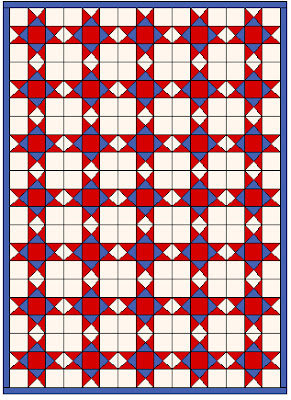For a 12" finished block you will need:
(1) 6-1/2" square for the center
(1) 7-1/2" square, cut twice diagonally (cut corner to corner, then without moving the pieces, cut it diagonally from corner to corner the other direction, with the cuts making an X in the square.
(2) 6-7/8" squares, cut once diagonally (These will be the outside triangles)
Why are you cut one of the squares twice, and the others just once? You want to try to have straight edges on the outside of a block, and when you cut just once diagonally the bias edge is along the long edge/hypotenuse and the straight edges on the other sides--just what we want to finish off the block, so there aren't any bias edges to worry about on the outer edges.
Arrange the pieces as below; the triangles that came from the larger squares that were cut twice are sewn to each side of the center square. Sew a triangle along one side, then a triangle on the opposite side. Then do the other two sides. Finally, sew the triangles that were cut from the 6-7/8" squares along the "new" square that you just created.
In the end, your block will look like:
You can make a quilt that is made of just Square in a Square block. I have done this quite a few times when I've made photo quilts, with photos as the center squares, and a scrappy look for the surrounding traingles.
You can also alternate the block with other 4-patch blocks, as with the Four Patch:
or a pinwheel:
The center square would also be a great place to showcase a large-scale print, such as a beautiful floral.































